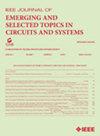用于神经形态边缘计算的超低成本多播异步 NoC
IF 3.8
2区 工程技术
Q2 ENGINEERING, ELECTRICAL & ELECTRONIC
IEEE Journal on Emerging and Selected Topics in Circuits and Systems
Pub Date : 2024-07-25
DOI:10.1109/JETCAS.2024.3433427
引用次数: 0
摘要
生物大脑越来越多地被用作更高效计算形式的指南。最新的前沿技术考虑使用基于尖峰神经网络的神经形态处理器进行近距离传感器数据处理,以适应边缘计算设备紧张的功率和资源预算。然而,在神经形态系统的设计中,对大脑启发计算和存储基元的普遍关注正将一个基本瓶颈推向前沿:芯片级通信。虽然通信架构(通常是片上网络)通常受到通用计算的启发,甚至是从通用计算中借鉴而来,但神经形态通信表现出独特的特点:它们包括在严格的面积和功耗预算内,将少量信息以事件驱动的方式路由到大量目的地。本文的目标是为大脑启发通信的片上网络设计找到一个拐点,将经济高效、稳健的异步设计、短信息传输的架构专业化以及基于树状组播的轻量级硬件支持结合起来。经功能性尖峰神经网络流量验证,与用于边缘计算应用的实际多核神经形态处理器中使用的最先进 NoC 相比,所提出的 NoC 可节省 42% 至 71% 的能源。本文章由计算机程序翻译,如有差异,请以英文原文为准。
An Ultra-Low Cost and Multicast-Enabled Asynchronous NoC for Neuromorphic Edge Computing
Biological brains are increasingly taken as a guide toward more efficient forms of computing. The latest frontier considers the use of spiking neural-network-based neuromorphic processors for near-sensor data processing, in order to fit the tight power and resource budgets of edge computing devices. However, a prevailing focus on brain-inspired computing and storage primitives in the design of neuromorphic systems is currently bringing a fundamental bottleneck to the forefront: chip-scale communications. While communication architectures (typically, a network-on-chip) are generally inspired by, or even borrowed from, general purpose computing, neuromorphic communications exhibit unique characteristics: they consist of the event-driven routing of small amounts of information to a large number of destinations within tight area and power budgets. This article aims at an inflection point in network-on-chip design for brain-inspired communications, revolving around the combination of cost-effective and robust asynchronous design, architecture specialization for short messaging and lightweight hardware support for tree-based multicast. When validated with functional spiking neural network traffic, the proposed NoC delivers energy savings ranging from 42% to 71% over a state-of-the-art NoC used in a real multi-core neuromorphic processor for edge computing applications.
求助全文
通过发布文献求助,成功后即可免费获取论文全文。
去求助
来源期刊

IEEE Journal on Emerging and Selected Topics in Circuits and Systems
ENGINEERING, ELECTRICAL & ELECTRONIC-
CiteScore
8.50
自引率
2.20%
发文量
86
期刊介绍:
The IEEE Journal on Emerging and Selected Topics in Circuits and Systems is published quarterly and solicits, with particular emphasis on emerging areas, special issues on topics that cover the entire scope of the IEEE Circuits and Systems (CAS) Society, namely the theory, analysis, design, tools, and implementation of circuits and systems, spanning their theoretical foundations, applications, and architectures for signal and information processing.
 求助内容:
求助内容: 应助结果提醒方式:
应助结果提醒方式:


